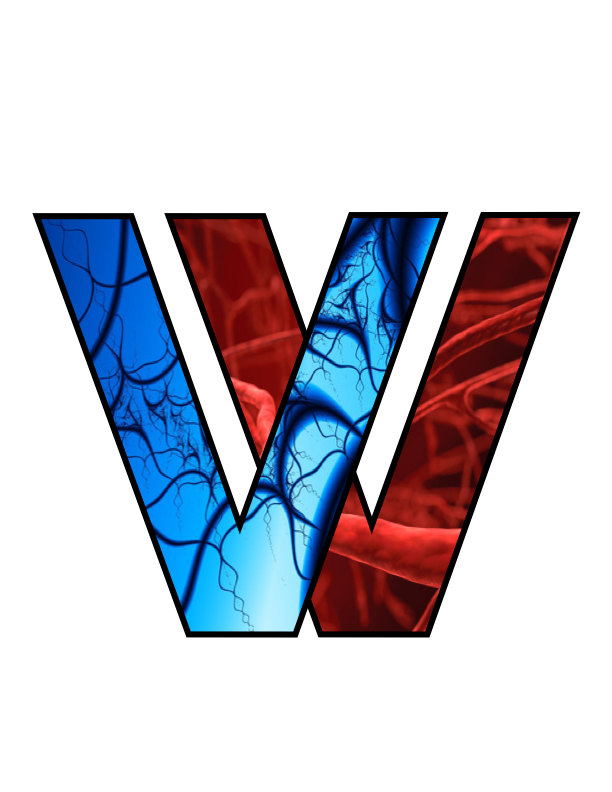



Glossary and Links
Abdominal Aortic Aneurysm: An abdominal aortic aneurysm is an enlarged area in the lower part of the aorta, the major blood vessel that supplies blood to the body.
Angiogram: An x-ray test that uses a special dye and camera (fluoroscopy) to take pictures of the blood flow in an artery or a vein.
Angioplasty: An endovascular procedure with a balloon-tipped catheter to enlarge a narrowing in an artery.
Arterial Duplex Scan: A painless exam that uses high-frequency sound waves (ultrasound) to capture internal images of the major arteries in the arms, legs and neck. A special gel is placed on the area being examined while a wand-like device called a transducer is passed lightly over the skin above the artery.
Arteriogram: X-ray test that uses dye to take pictures of the blood vessels. It is performed to evaluate various vascular conditions, such as aneurysm, stenosis, or blockages.
Atherosclerosis: A disease of the arterial blood vessels, in which the walls of the arteries become thickened and hardened by plaques. Plaques are composed of cholesterol and other lipids, inflammatory cells, and calcium deposits; also called "hardening of the arteries."
Bypass: A surgical procedure that reroutes the blood supply around “plaque blocked” areas.
CVD – Chronic Venous Disorder.
Carotid Stenosis: Carotid stenosis is the narrowing of the carotid arteries, usually caused by atherosclerosis.
Cholesterol: A fat-like substance that is made by the human body and found in animal products. Cholesterol is used to form cell membranes and process hormones and vitamin D. High cholesterol levels contribute to the development of atherosclerosis.
Angiogram: An x-ray test that uses a special dye and camera (fluoroscopy) to take pictures of the blood flow in an artery or a vein.
Angioplasty: An endovascular procedure with a balloon-tipped catheter to enlarge a narrowing in an artery.
Arterial Duplex Scan: A painless exam that uses high-frequency sound waves (ultrasound) to capture internal images of the major arteries in the arms, legs and neck. A special gel is placed on the area being examined while a wand-like device called a transducer is passed lightly over the skin above the artery.
Arteriogram: X-ray test that uses dye to take pictures of the blood vessels. It is performed to evaluate various vascular conditions, such as aneurysm, stenosis, or blockages.
Atherosclerosis: A disease of the arterial blood vessels, in which the walls of the arteries become thickened and hardened by plaques. Plaques are composed of cholesterol and other lipids, inflammatory cells, and calcium deposits; also called "hardening of the arteries."
Bypass: A surgical procedure that reroutes the blood supply around “plaque blocked” areas.
CVD – Chronic Venous Disorder.
Carotid Stenosis: Carotid stenosis is the narrowing of the carotid arteries, usually caused by atherosclerosis.
Cholesterol: A fat-like substance that is made by the human body and found in animal products. Cholesterol is used to form cell membranes and process hormones and vitamin D. High cholesterol levels contribute to the development of atherosclerosis.
Dialysis: The artificial process of eliminating waste (diffusion) and unwanted water (ultrafiltration) from the blood. Our kidneys do this naturally. Some people, however, may have failed or damaged kidneys which cannot carry out the function properly - they may need dialysis.
Dialysis Access: Allows your physician to deliver medicine directly into your bloodstream without repeatedly puncturing your blood vessels through various access methods, such as: a catheter, an AV fistula, an AV graft or peritoneal.
Doppler Ultrasound: A non-invasive test that uses high frequency soundwaves to measure the amount of blood flow through your blood vessels.
Duplex Ultrasound: Combines traditional ultrasound - Sound waves that bounce off blood vessels to create pictures and Doppler ultrasound - Records high frequency sound waves reflecting off moving objects, such as blood, to measure their speed and other aspects of how they flow.
Endarterectomy: A surgical procedure in which material occluding the carotid artery is cleaned out, thereby restoring normal blood flow to the brain and preventing a stroke.
Endovascular Surgery: Endovascular surgery is an innovative, less invasive procedure used to treat issues affecting the blood vessels, such as an aneurysm, which is a swelling or "ballooning" of the blood vessel. The surgery involves making a small incision near each hip to access the blood vessels.
Fibromuscular Dysplasia: Abnormal cell growth in the artery walls that causes narrowing and a "string of beads" appearance; usually affects arteries of the kidneys and brain.
Hemorrhagic Stroke: Stroke caused by the rupture of a blood vessel in the brain.
Dialysis Access: Allows your physician to deliver medicine directly into your bloodstream without repeatedly puncturing your blood vessels through various access methods, such as: a catheter, an AV fistula, an AV graft or peritoneal.
Doppler Ultrasound: A non-invasive test that uses high frequency soundwaves to measure the amount of blood flow through your blood vessels.
Duplex Ultrasound: Combines traditional ultrasound - Sound waves that bounce off blood vessels to create pictures and Doppler ultrasound - Records high frequency sound waves reflecting off moving objects, such as blood, to measure their speed and other aspects of how they flow.
Endarterectomy: A surgical procedure in which material occluding the carotid artery is cleaned out, thereby restoring normal blood flow to the brain and preventing a stroke.
Endovascular Surgery: Endovascular surgery is an innovative, less invasive procedure used to treat issues affecting the blood vessels, such as an aneurysm, which is a swelling or "ballooning" of the blood vessel. The surgery involves making a small incision near each hip to access the blood vessels.
Fibromuscular Dysplasia: Abnormal cell growth in the artery walls that causes narrowing and a "string of beads" appearance; usually affects arteries of the kidneys and brain.
Hemorrhagic Stroke: Stroke caused by the rupture of a blood vessel in the brain.
LDL Cholesterol: Low-density lipoprotein cholesterol is the primary cholesterol molecule. High levels of LDL, nicknamed "bad" cholesterol, increase the risk of atherosclerosis.
Lumen: The inside diameter of a blood vessel or hollow organ.
Occlusion: An obstruction or closure of a passageway or vessel.
Peripheral Arterial Disease: Peripheral arterial disease is a common circulatory problem in which narrowed arteries reduce blood flow to your limbs.
Plaque: A sticky substance made of fat, cholesterol, calcium and other fibrous material.
A Renal Artery Duplex Is an ultrasound test that uses high frequency sound waves (ultrasound) to examine the renal arteries and measure the blood flow. The renal arteries deliver blood to the kidneys.
Renal Artery Stenosis: Renal artery stenosis is a narrowing of arteries that carry blood to one or both kidneys. Most often seen in older people with atherosclerosis (hardening of the arteries). Renal artery stenosis can worsen over time and often leads to hypertension (high blood pressure) and kidney damage.
Stent: A tube-like device that is inserted into a vessel or passageway to keep it open.
Lumen: The inside diameter of a blood vessel or hollow organ.
Occlusion: An obstruction or closure of a passageway or vessel.
Peripheral Arterial Disease: Peripheral arterial disease is a common circulatory problem in which narrowed arteries reduce blood flow to your limbs.
Plaque: A sticky substance made of fat, cholesterol, calcium and other fibrous material.
A Renal Artery Duplex Is an ultrasound test that uses high frequency sound waves (ultrasound) to examine the renal arteries and measure the blood flow. The renal arteries deliver blood to the kidneys.
Renal Artery Stenosis: Renal artery stenosis is a narrowing of arteries that carry blood to one or both kidneys. Most often seen in older people with atherosclerosis (hardening of the arteries). Renal artery stenosis can worsen over time and often leads to hypertension (high blood pressure) and kidney damage.
Stent: A tube-like device that is inserted into a vessel or passageway to keep it open.
Thoracic Aneurysm: A thoracic aortic aneurysm is an aortic aneurysm that presents primarily in the thorax. A thoracic aortic aneurysm is the "ballooning" of the upper aspect of the aorta, above the diaphragm.
Transient Ischemic Attack (TIA): A "mini" stroke caused when blood flow to the brain is temporarily interrupted and then restored; causes no permanent brain damage.
Vasculitis: Inflammation of blood vessels.
Venous Disease: Chronic Venous Disease (CVD) refers to other chronic conditions related to or caused by veins that become diseased or abnormal.
Venous Duplex Scan Is a painless exam that uses high-frequency sound waves (ultrasound) to capture images of internal views of veins that return blood to the heart. During an upper extremity venous duplex scan, the veins in your neck, shoulders, arms and wrists are viewed.
Transient Ischemic Attack (TIA): A "mini" stroke caused when blood flow to the brain is temporarily interrupted and then restored; causes no permanent brain damage.
Vasculitis: Inflammation of blood vessels.
Venous Disease: Chronic Venous Disease (CVD) refers to other chronic conditions related to or caused by veins that become diseased or abnormal.
Venous Duplex Scan Is a painless exam that uses high-frequency sound waves (ultrasound) to capture images of internal views of veins that return blood to the heart. During an upper extremity venous duplex scan, the veins in your neck, shoulders, arms and wrists are viewed.



